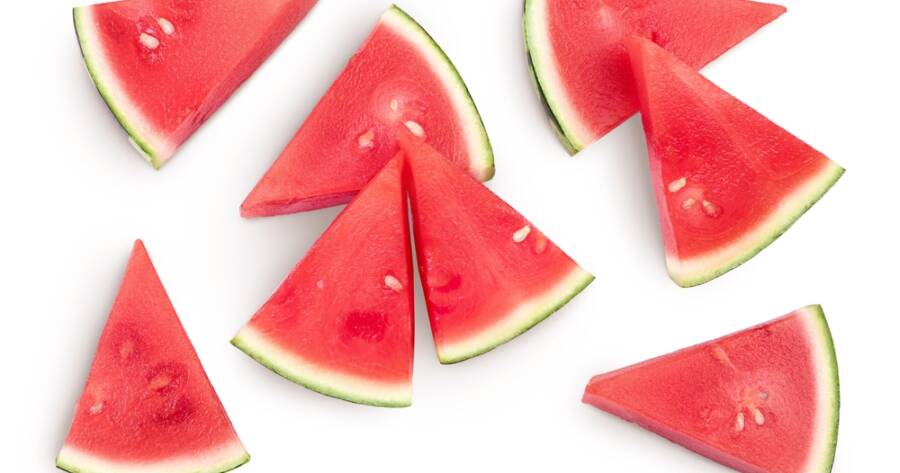When you think about staying hydrated, water probably comes to mind first, but your plate can be just as important as your water bottle. Many fruits and vegetables are loaded with water and essential nutrients that support your energy, digestion, and skin from the inside out. Whether you’re battling summer heat or just trying to feel your best, these hydrating foods go the extra mile, delivering more than just a sip-worthy boost.
Watermelon
Watermelon is more than just a summer snack, it’s made up of over 90% water and loaded with electrolytes like potassium and magnesium. Each juicy bite helps replenish fluids while giving you a gentle boost of vitamins A and C, which support skin health and immune function.
It also contains lycopene, a powerful antioxidant that may help reduce inflammation and protect against sun damage, making it the perfect warm-weather companion. Blend it into smoothies, cube it for salads, or enjoy it straight from the fridge. However you slice it, watermelon delivers hydration and health benefits that go way beyond its sweet, refreshing flavor.
Cucumber
Cucumbers are another hydration powerhouse, with a water content of about 96%. They’re crisp, cooling, and incredibly versatile, perfect for snacking, tossing in salads, or blending into smoothies. Plus, they’re rich in silica, a compound that supports skin elasticity and joint health.
Cucumbers are also known for their anti-inflammatory and digestive-supporting properties. Pair them with a pinch of sea salt and a squeeze of lemon for an easy hydrating snack, or slice them into water for an instant spa-like upgrade. Their high water volume and low calorie count make them a great option for staying full without feeling heavy, especially on hot or sluggish days.
Strawberries
Strawberries are about 92% water, making them a sweet and satisfying way to stay hydrated while boosting your antioxidant intake. They’re packed with vitamin C and fiber, which help support immunity and digestion, all while keeping your hydration levels up.
Add them to yogurt, blend them into smoothies, or enjoy them fresh by the handful. Their natural sugars offer a gentle energy lift without the crash, and the added fiber helps slow digestion, keeping you fuller longer. Strawberries are also great for skin health, thanks to their vitamin C content, which supports collagen production and a healthy glow.
Zucchini
Zucchini flies under the radar, but it’s made up of about 95% water, and it’s full of nutrients like vitamin A, potassium, and manganese. Whether you sauté it, spiralize it, or add it raw to salads, zucchini brings hydration and a mild, adaptable flavor to your plate.
Because it’s so light, it pairs well with heavier dishes and helps you feel satisfied without being weighed down. It’s also low in calories but high in fiber and antioxidants, making it a great option for digestion and overall gut health. If you’re not already sneaking zucchini into everything from pastas to baked goods, it’s time to start, your body (and hydration levels) will thank you.
Celery
Celery is often praised for its crunch, but it’s also incredibly hydrating. Made of nearly 95% water and full of essential electrolytes like sodium, potassium, and magnesium. These minerals help maintain your fluid balance, making celery a great choice before or after workouts or on particularly hot days.
It’s also a good source of fiber and antioxidants, especially in the pale green leaves at the top. Enjoy celery with hummus, almond butter, or just plain for a satisfying, low-calorie snack. Its natural sodium content helps your body retain fluids in a healthy way — perfect for supporting hydration without needing sugary sports drinks.
Lettuce
Don’t overlook lettuce when thinking about hydration. Varieties like iceberg, butterhead, and romaine are composed of 95% or more water, making them a smart base for meals when you want something fresh and fluid-filled. Plus, they bring a light crunch and mild flavor that pairs with almost anything.
While iceberg has a reputation for being low in nutrients, it still contributes hydration and volume to your meals. Romaine, on the other hand, offers more vitamins like A, K, and folate. Mix different types for texture and nutritional variety. Whether you use it in a salad, wrap, or sandwich, lettuce helps you stay hydrated and energized, especially when the temperature rises.
Sip Less, Eat More (Water)
Hydration doesn’t have to come from a bottle. Adding water-rich foods like watermelon, cucumbers, and berries to your meals helps you stay refreshed, energized, and nourished, all while sneaking in extra vitamins and minerals. These foods do more than quench thirst; they support digestion, skin health, and energy levels throughout the day. So next time you reach for water, reach for a fork too! Your body will thank you for both.

